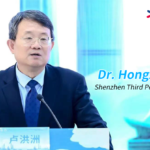
Editor’s note: Portal hypertension (PHT) in cirrhosis is a leading cause of complications in patients with compensated chronic liver disease (cACLD). Clinically significant portal hypertension (CSPH) is closely linked to the development of varices, decompensation, hepatocellular carcinoma, and high mortality rates. Non-selective beta-blockers (NSBBs), particularly carvedilol, have shown significant benefits in reducing decompensation and mortality risk in patients with CSPH, fundamentally changing the management of cirrhosis. However, the gold standard for CSPH diagnosis—hepatic venous pressure gradient (HVPG) measurement—is invasive and not widely applicable. Therefore, identifying suitable candidates for NSBB therapy in routine clinical practice has become a crucial issue.Editor’s note: Portal hypertension (PHT) in cirrhosis is a leading cause of complications in patients with compensated chronic liver disease (cACLD). Clinically significant portal hypertension (CSPH) is closely linked to the development of varices, decompensation, hepatocellular carcinoma, and high mortality rates. Non-selective beta-blockers (NSBBs), particularly carvedilol, have shown significant benefits in reducing decompensation and mortality risk in patients with CSPH, fundamentally changing the management of cirrhosis. However, the gold standard for CSPH diagnosis—hepatic venous pressure gradient (HVPG) measurement—is invasive and not widely applicable. Therefore, identifying suitable candidates for NSBB therapy in routine clinical practice has become a crucial issue.Non-invasive tests (NITs), such as liver stiffness measurement (LSM), spleen stiffness measurement (SSM), and platelet count (PLT), have been validated for diagnosing CSPH and predicting decompensation risk. However, these methods have limitations when used alone, especially for patients in the “gray zone” with LSM values between 15-25 kPa, where diagnostic uncertainty requires further investigation. In light of these limitations, a recent study published in the Journal of Hepatology evaluated a new algorithm combining NITs (LSM, SSM, PLT) and endoscopy to improve CSPH diagnostic accuracy, based on a cohort from the PREDESCI trial. The goal is to better identify patients requiring NSBB therapy and prevent disease progression and decompensation in cirrhotic patients.
The study included compensated cirrhosis patients screened in the PREDESCI trial who underwent liver elastography. The researchers assessed the performance of a model based on LSM and PLT, then developed an algorithm involving endoscopy for patients with indeterminate NIT results (“gray zone”), validating it in an independent cohort of 195 patients.
Baveno VII Model Performance
The Baveno VII criteria excluded CSPH with 98% sensitivity (95% CI: 94%-99%) and a negative predictive value (NPV) of 82% (95% CI: 50%-96%). However, 47% of patients (n=80) fell into the gray zone, with a 9% risk of decompensation or death within three years. Using LSM ≥25 kPa as the CSPH diagnostic threshold resulted in a specificity of 82% (95% CI: 69%-92%) and a positive predictive value (PPV) of 89% (95% CI: 81%-93%), with a three-year cumulative risk of decompensation or death at 21% in this group.
AASLD Model Performance
The AASLD criteria (LSM ≥25 kPa or LSM >20 kPa with thrombocytopenia) reduced the number of patients in the gray zone to 63 (37%), but specificity was 76% (95% CI: 63%-87%) and PPV was 88% (95% CI: 50%-96%), leaving 29% of CSPH patients outside the high-risk category. The three-year risk of decompensation or death in the gray zone was still 9%.
New Algorithm (Combining Baveno VII/AASLD Criteria and Endoscopy)
For patients meeting AASLD criteria for CSPH diagnosis (LSM ≥25 kPa or LSM >20 kPa with thrombocytopenia), endoscopic examination was performed on 63 gray zone patients, identifying 26 with varices who were reclassified as high-risk. The new algorithm achieved a specificity of 61% (95% CI: 46%-74%) and a PPV of 84% (95% CI: 78%-88%), significantly reducing the gray zone to 22% (P=0.002), and correctly classified 86% of CSPH patients as high-risk. According to the new algorithm, no decompensation events occurred in patients from the gray and low-risk categories within three years.
Performance in the Validation Cohort
The validation cohort included 195 patients, 63% of whom had CSPH (n=122), and 51% had esophagogastric varices (n=89). The median follow-up period was 42 months, with a three-year risk of decompensation or death at 13.3%. In this cohort, the algorithm combining AASLD criteria and endoscopy achieved 85% specificity and 91% PPV, reducing the gray zone to 31% (P=0.003), with only 13% of CSPH patients outside the high-risk category. Using a completely non-invasive algorithm combining Baveno VII criteria and SSM yielded similar results.
The researchers concluded that algorithms solely based on LSM and PLT performed poorly in identifying candidates for NSBB therapy. Performing endoscopy for patients with uncertain NIT results significantly improved diagnostic performance and risk stratification. Additionally, SSM may be considered as an alternative to endoscopy for fully non-invasive risk assessment in gray zone patients, but further studies are needed.


